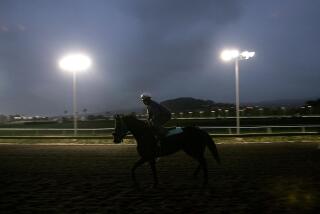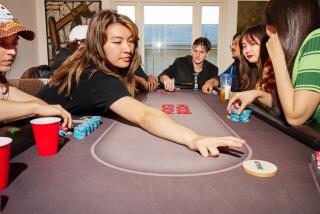THE RUSH WAS ON : On Sept. 3, 1906, in Goldfield, Nev., Two Lightweights Struck It Rich
GOLDFIELD, Nev. — A cold wind swept across the high desert valley, blowing dust, tumbleweeds and paper scraps toward the foothills, toward the little town’s cemetery.
A wire fence surrounded the scruffy little graveyard, and the wind made the wires emit a low, mournful hum. The wind also made the hundreds of old wooden crosses tremble.
Very few graves in Goldfield’s cemetery have headstones. Most graves are marked with wooden crosses. No names, no dates. In Goldfield, people were in a hurry.
There was gold here.
Looking west, Goldfield seems to be in a state of arrested decay now, as it has been since the 1920s, when the gold mines began to play out. Hundreds of decades-old wooden shacks are slowly blowing away, splinter by splinter.
All over town, Model-A era cars lie rusting, slowly being swallowed by the earth.
From the cemetery, one can see the dominant buildings in town: the four-story Goldfield Hotel (1908), the Esmeralda County Courthouse (1907), the firehouse (1908) and the brick high school (1907), which was boarded up in 1957.
To the north of town, two blocks from the hotel, one can see where a flood wash has flattened the earth. On that site, 82 years ago, a Goldfield saloon owner, Tex Rickard, built a 7,000-seat wooden arena around a boxing ring. For nearly three hours one day, Sept. 3, 1906, all telegraph wires in the United States were connected to Goldfield, Nev.
On June 27, 1988, a couple of heavyweights will fight in Atlantic City, N.J., for a total of about $33 million. On Sept. 3, 1906, lightweights Joe Gans and Battling Nelson fought for $34,000 in Goldfield.
Doesn’t sound like much, does it? The guy selling the T-shirts at the Tyson-Spinks fight will probably make that.
But 82 years ago, $34,000 was by far the biggest purse offered for a boxing match.
Gans, Nelson, Rickard.
Three men, drawn together to make history, to a place not as unlikely as you might think. Goldfield, you see, had what all three wanted:
Gold.
U.S. 95 runs through Goldfield, 180 miles north of Las Vegas. At an elevation of 5,690 feet, its summer mornings are cool. In 1906, it was the largest city in Nevada, with about 30,000 people living in wooden lean-tos, shacks and tents. A panoramic photograph of the day, possibly taken from a balloon, shows the little valley covered with small structures and crisscrossed by dirt streets.
Today, Goldfield is stirring again. New cyanide mining technology enables miners to drain gold out of the many ore piles discarded by miners of old.
Ten years ago, Goldfield was closing in on ghost-town status. The population was down to 150. Now it’s up to 600. And the Goldfield Hotel, where the last guest checked out in 1946, is about to breathe again. A San Francisco developer, Lester Oshea, has been remodeling the 101-room hotel the past three years, and its reopening is scheduled for Labor Day weekend.
Before 1900, Nevada had been in a 20-year mining depression, and the state had lost one-third of its population. Then, a series of gold strikes occurred.
The first one was at Tonopah. The second, in 1902, was at Goldfield. Two prospectors, Harry Stimler and Billy Marsh, hit a strike in the town’s foothills. Goldfield boomed. Between 1904 and 1918, $88 million in minerals came out of Goldfield, and the city’s population grew to 30,000.
In one three-month period one Goldfield mine yielded $5 million in gold.
A ton of common surface dirt in Goldfield usually resulted in $100 to $500 in gold. When the Hayes-Monette mine operators sent one ore shipment to a California smelter, they received a check for $500,000.
Prospectors, hardware salesmen, merchants, gamblers and saloon owners flocked to Goldfield. At one point, the city had 53 saloons. One of them is still in business, the Santa Fe Saloon, built in 1904. It’s well known to locals for the homemade tomato soup.
Prostitutes operated out of one-room dwellings downtown, simply hanging out signs reading “Jenny,” “Mary,” etc.
One of the early arrivals was a migrant cowboy/prospector who’d first grown weary of herding steers in the Texas panhandle. After that, he made and lost a fortune in the Klondike Gold Rush.
George Lewis (Tex) Rickard craved action. He yearned to own a saloon and see it filled with drunken men with gold in their pockets.
What this town needed was a major prize fight, Rickard decided. One day in his Northern Saloon and Gambling Casino (an abandoned gas station stands at the site today), he assembled several of Goldfield’s wealthiest citizens and proposed a Nelson-Gans world lightweight championship boxing match for the city. And why not? Nevada, in 1906, was the only state in the union where prize fights were legal.
Rickard and his friends formed a corporation, calling themselves the Goldfield Athletic Club.
Rickard first wired Battling Nelson’s manager, Billy Nolan, stating:
“Will give you $20,000 fight Gans. Fight (to finish) Labor Day. Money posted J.S. Cooke and Company Bank, Goldfield. Answer immediately.--Rickard.”
Nelson signed. Then Rickard set out to find Gans, the onetime Baltimore fish-market clerk who had risen to a position of preeminence in boxing. In his 1958 book, “Fifty Years at Ringside,” boxing historian Nat Fleischer rated Gans No. 1 on his list of lightweights.
Rickard found Gans in San Francisco. He signed him, too. Stepping off his return train trip in Reno, Nev., Rickard walked to a lumber yard and ordered enough lumber to build a 7,000-seat arena, and had it shipped to Goldfield.
In late August, 1906, boxing writers and fans from across the United States arrived in Goldfield. On fight day, in a boxing first, women and children were admitted. The house was scaled from $5 to $25, and the crowd was 7,491.
Gans, 31, a stand-up boxer, was a 10-7 favorite over Nelson, 24, a brawler from Copenhagen.
On a hot afternoon, they fought for nearly three hours, through 42 rounds. Gans built a lead from the start, easily sidestepping most of Nelson’s charges and peppering him with left jabs and counterpunches.
In the 33rd round, Gans broke his right wrist and never threw another right. But with one hand, he maintained what seemed to be a clear lead over the Dane but couldn’t put him away. In the 42nd round, Nelson hit Gans well below the belt, with a punch most in the arena believed to be deliberately low.
While Gans writhed in pain on the floor, referee George Siler declared him the winner on a foul.
Today, Battling Nelson’s personal scrapbooks--10 volumes--are owned by the Amateur Athletic Foundation library in Los Angeles. One of the volumes is filled exclusively with accounts of the fight, clipped from San Francisco newspapers.
A reporter for the San Francisco Bulletin, Pauline Jacobson, described the crowd that day this way:
“Five hundred women were present, about 100 were not respectable.”
Of the finish, she wrote: “ . . . the glory of Goldfield came down upon Gans, in the hearts of those who saw him fight so clean and princely.
Wrote the Associated Press: “The foul was so obvious that not even men who had bet on Nelson could say that it had not been committed . . . throughout the long contest, Nelson had used rough tactics . . . Nelson and his outfit were hissed as they departed.”
From the San Francisco Call: “It was a bloody battle, a brutal show for some hundreds of women and a few children, who were--for the first time in ring history--admitted to an arena where only men should have been.”
One writer reported that two Goldfield citizens didn’t see the bout--the telegraph operator at the train depot to whom runners brought the boxing reporters’ copy, and a drunk who attempted a saloon burglary during the fight.
“Finding no money in the till,” the writer reported, “he killed himself. The telegraph operator was informed of this event and wired the arena. But no one would leave to tend to the body until after the contest.”
The gross gate was reported as $69,715. Nelson earned $23,000, Gans $11,000, plus another $6,500 from bets he’d placed on himself.
After the bout, the fighters’ representatives met with Rickard at the J.S. Cook and Company Bank. A strongbox containing gold coin, notes and checks was opened, and the principals were paid.
As the promoter, Rickard made a small fortune. But he was a loser, too. Years later, he admitted he’d bet heavily on Nelson.
Gans and Nelson fought two more times. Nelson knocked him out twice in 1908, but Gans was by then in the beginning stages of tuberculosis.
Today, you can stand on a small hill near the Goldfield airstrip, look across the wash and see the Goldfield Hotel and a few other brick buildings of old Goldfield that still stand.
The desert wind carries the sound of the town’s barking dogs across the wash, where Tex Rickard built his wooden arena.
Rickard, of course, went on to greater achievements.
First, though, he bought a fancy Goldfield house. The Victorian home still stands, at 420 E. Crook St. His front yard, it’s said, had the first grass lawn in Goldfield.
He moved on to Rawhide, Nev., in 1908, and started another saloon. By 1910, he was in Reno, where he promoted the Jack Johnson-Jim Jeffries fight.
In the 1920s, he promoted boxing’s first million-dollar gates, including both Dempsey-Tunney fights. Boxing made him a millionaire, and he multiplied his fortune investing in Miami Beach real estate.
Tex Rickard died of appendicitis, on Jan. 6, 1929, in Miami Beach. He was 58. He was buried in a 2,200-pound bronze casket at Woodlawn Cemetery in New York.
Joe Gans died of tuberculosis on Aug. 10, 1910. He was 35. He is buried in Mt. Auburn Cemetery in Westport, Md.
Battling Nelson died of lung cancer in Chicago, on Feb. 7, 1954. He was 71. He’d successfully invested much of the $500,000 he’d earned in his 20-year boxing career but lost it all in the Depression. When he died, he weighed 80 pounds and was living on a $22-a-month Post Office pension and handouts from friends.
Hundreds were turned away from Nelson’s funeral. He is buried in Eden Cemetery in Chicago.
More to Read
Sign up for Essential California
The most important California stories and recommendations in your inbox every morning.
You may occasionally receive promotional content from the Los Angeles Times.










